When it comes to picking a sword, it’s not uncommon to hear the question “What is the best sort of sword steel”. This type of the question is not easily answered, the best sort of steel depends largely on what the sword will be used for and what budget the buyer has. For example, someone that is looking purely for a decorative display piece will likely want a steel that remains shiny with very little maintenance. A stainless steel sword will probably meet this buyers requirements, the sword will remain bright and polished for years, however the sword will be useful for very little else apart from hanging on the wall. If on the other hand the shopper would like a real battle ready sword, one which is capable of taking and retaining a cutting edge, then the choice of steel is a little harder. Additionally, we may need to consider sword tempering and forging methods. We’ll go into more depth in the article below.
Sword Tempering
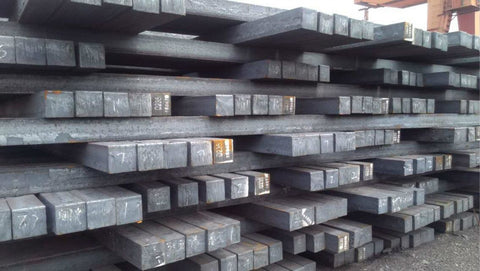
A sword begins its life as a billet of steel, this billet is heated and roughly formed into a sword like shape. This process may take a couple of hours, or a couple of dozen hours, largely depending on the size and type of sword required. Once the sword has been shaped into its final form, the sword will most often go under a procedure called tempering. Tempering is a key aspect of producing a functional sword, the steps involved are quite technical in nature and have a significant impact on the swords capabilities. Essentially tempering involves heating the sword to pre-defined temperatures, the sword is then rapidly cooled in oil or water (but not too rapidly). The tempering process is key to producing a hardened and tough blade. However, if the sword is cooled too quickly then the sword may end up being brittle or cracking. Many thousands of swords have met an untimely end during the tempering process. Sword tempering will have one of the biggest effects on the final swords capabilities, sometimes more than the type of steel chosen.
Most swords are either mono hardened or differentially hardened. In a mono hardened sword, the whole sword is heated to the same uniform temperature and cooled at the same rate. In a differentially hardened sword, clay or other similar pastes are added to the blade in order to insulate part of the sword from the heating and cooling process. When this occurs the clay covered part will cool at a slower pace compared to the exposed part of the blade, this works to increase the hardness of the exposed blade while allowing the covered portion to remain flexible. The differential hardening process is very common in Japanese swords such as a Samurai Sword, creating the distinctive Hamon line. A Hamon line is the separation between the hard cutting edge and the softer flexible spine. A flexible spine allows the sword to absorb impacts which would otherwise dent or crack the sword.
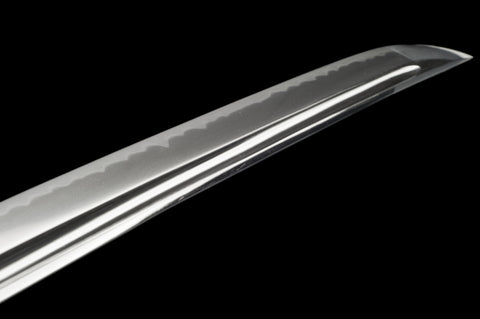
Mono tempered swords are typically marketed at beginners, they are able to take more abuse and are less likely to chip or become permanently misshapen. Despite the association with beginners, there are a lot of good arguments for buying a mono tempered sword over a traditional differentially tempered variety. Most of the swords originating from medieval Europe where forged using mono tempering methods, which was better suited to the slashing blows against armour and shields, the mono temper is better suited to taking punishment without chipping or breaking.
If you’re experienced using a sword for cutting, then you may wish to consider a differentially tempered. These swords typically have a harder cutting edge, but you’ll need to be wary of form and technique, a misguided sword stroke may lead to the blade being chipped or irrevocably damaged.
Most experienced sword makers today are well versed in the art of sword tempering, so there’s little concern around receiving a cracked or chipped sword, simply choose the tempering you’d like.
Sword Steel Guide
Now that we’ve managed to cover tempering and what the means for your sword, we can move onto the types of sword steel that are available. Picking a steel for your sword is only really important if you’re looking to have a battle ready sword. If you’re only looking for a display sword then you’re probably better of getting a sword made from stainless steel, they are cheaper to buy and require very little maintenance, they are however not recommended for any substantial cutting. I’m not trying to imply that all stainless steel swords are terrible for cutting, but I wouldn’t expect to slice through 3 inches of bamboo with one either.
So what about carbon steel? Carbon steel is the go to sword steel for battle ready swords, at the lower end of the scale we start at 1045 carbon steel. The number assigned to the carbon steel describes the carbon content of the metal. For example, 1045 is classed as medium carbon content and will contain 0.45% carbon. Continuing with the naming convention, 1060 carbon steel has 0.60% carbon content and so on. Most carbon steel swords you’ll find for sale are 1045, 1060 or 1095. Some sword smiths are embracing newer types of steel for use in swords such as 9260 and other types of spring steel, these have added silicon which increases the blades toughness. This naming convention is very similar to the carbon steel, the key difference is that the first two numbers have been changed. The 92 in 9260 signifies that Silicon Manganese has been incorporated into the steel. The chart below shows all the different sorts of steel that are available, not all are used in sword making.
|
10XX
|
Carbon steels
|
Plain carbon, Mn 1.00% max
|
|
11XX
|
Resulfurized free machining
|
|
|
12XX
|
Resulfurized / rephosphorized free machining
|
|
|
15XX
|
Plain carbon, Mn 1.00-1.65%
|
|
|
13XX
|
Manganese steel
|
Mn 1.75%
|
|
23XX
|
Nickel steels
|
Ni 3.50%
|
|
25XX
|
Ni 5.00%
|
|
|
31XX
|
Nickel-chromium steels
|
Ni 1.25%, Cr 0.65-0.80%
|
|
32XX
|
Ni 1.75%, Cr 1.07%
|
|
|
33XX
|
Ni 3.50%, Cr 1.50-1.57%
|
|
|
34XX
|
Ni 3.00%, Cr 0.77%
|
|
|
40XX
|
Molybdenum steels
|
Mo 0.20-0.25%
|
|
44XX
|
Mo 0.40-0.52%
|
|
|
41XX
|
Chromium-molybdenum steels
|
Cr 0.50-0.95%, Mo 0.12-0.30%
|
|
43XX
|
Nickel-chromium-molybdenum steels
|
Ni 1.82%, Cr 0.50-0.80%, Mo 0.25%
|
|
47XX
|
Ni 1.05%, Cr 0.45%, Mo 0.20-0.35%
|
|
|
46XX
|
Nickel-molybdenum steels
|
Ni 0.85-1.82%, Mo 0.20-0.25%
|
|
48XX
|
Ni 3.50%, Mo 0.25%
|
|
|
50XX
|
Chromium steels
|
Cr 0.27-0.65%
|
|
51XX
|
Cr 0.80-1.05%
|
|
|
50XXX
|
Cr 0.50%, C 1.00% min
|
|
|
51XXX
|
Cr 1.02%, C 1.00% min
|
|
|
52XXX
|
Cr 1.45%, C 1.00% min
|
|
|
61XX
|
Chromium-vanadium steels
|
Cr 0.60-0.95%, V 0.10-0.15%
|
|
72XX
|
Tungsten-chromium steels
|
W 1.75%, Cr 0.75%
|
|
81XX
|
Nickel-chromium-molybdenum steels
|
Ni .30%, Cr 0.40%, Mo 0.12%
|
|
86XX
|
Ni .55%, Cr 0.50%, Mo 0.20%
|
|
|
87XX
|
Ni .55%, Cr 0.50%, Mo 0.25%
|
|
|
88XX
|
Ni .55%, Cr 0.50%, Mo 0.35%
|
|
|
92XX
|
Silicon-manganese steels
|
Si 1.40-2.00%, Mn 0.65-0.85%, Cr 0-0.65%
|
|
93XX
|
Nickel-chromium-molybdenum steels
|
Ni 3.25%, Cr 1.20%, Mo 0.12%
|
|
94XX
|
Ni 0.45%, Cr 0.40%, Mo 0.12%
|
|
|
97XX
|
Ni 0.55%, Cr 0.20%, Mo 0.20%
|
|
|
98XX
|
Ni 1.00%, Cr 0.80%, Mo 0.25%
|
In this chart the first 2 numbers describe the type of steel and the last two numbers signify the carbon content. It’s easy to be confused by all the options available. To simplify matters, most of the sword we’ll be interested in are made from either 1045, 1060 or 1095 carbon steel, with a couple of exceptions thrown in. In the rest of the article we’ll cover the most commonly used sword steels available today and what properties they impart to the sword.
Types of Sword Steel
1045 Carbon Steel
1045 carbon steel has a carbon content of 0.45%, while a steel such as 1095 has 0.95% carbon content, contrariwise 1045 has more manganese content than 1095. This means that 1095 carbon steel is harder and better able to resist wear and tear, but it’s also less tough. 1045 is capable of taking an edge, but 1095 is easier to sharpen and the edge will last longer. If you’re a beginner, you might want to pick a 1045 carbon steel sword, they are better suited to taking abuse and are most often the cheapest battle ready sword available.
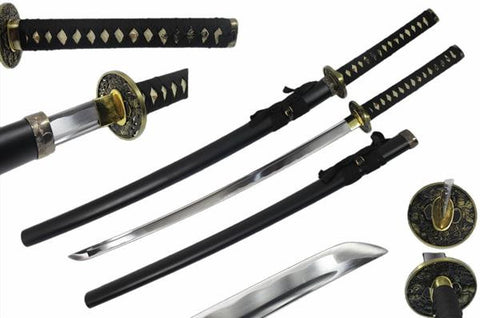
1050-1055 Carbon Steel
1050 carbon steel is a robust and resilient medium-high carbon steel. It has a carbon content of 0.50% and is good choice for anyone looking for a tough tool such an axe, hatchet or sword.
1055 carbon steel is right on the dividing line between steel classed as medium carbon content and steel classed as high carbon content. Typically 1055 carbon steel will have a manganese content between 0.60% and 0.90%. These factors contribute to any sword made from 1055 steel being incredibly tough and durable. When a 1055 sword is expertly tempered, it produces a crystalline structure which is free from excess carbides, in turn this avoids the brittleness which is common with high carbon materials. 1055 steel is very well suited to applications where impact resilience and outstanding toughness are highly desirable. This steel is capable of producing blades which are incredibly resilient to damage.
1060-1065 Carbon Steel
1060 and 1065 carbon steel is a fairly common steel used in battle ready swords. The carbon content is between 0.60% and 0.65%, with manganese being the only other addition. This sort of carbon steel is very tough and is able to take and retain an edge very well.
1065 is an ideal steel for differential hardening, often producing a visible temper line on the finished sword. Of course any hardening that takes place will also reduce the impact resilience of the finished piece.
1075 Carbon Steel
1075 carbon steel would be considered high carbon content steel. 1075 steel is excellent at taking and retaining an edge, the blade is very tough and is very resilient. The steel is very well suited for swords, axes, machetes, knives or any other sort of blade which requires a sharp edge and is subject to significant usage.
1095 Carbon Steel
1095 carbon steel is a standard production carbon steel, the steel is characterised by it’s low resistance to corrosion and it’s medium edge retention. A sword made from 1095 carbon steel is very easy to sharpen to a razor sharp long lasting edge. When this steel is expertly tempered, the sword is has amazing properties, no other steel can compare when expertly sharpened. We do not recommend this sword to beginners as it needs to be cared for correctly to avoid rusting and can be damaged if not used with proper technique and methods. In the correct hands a battle ready 1095 steel katana is incomparable.
65Mn Steel
65Mn steel is a widely used and available Chinese steel that was created in order to provide good hardness and increased wear resistance. The carbon content of this steel is classed as medium, allowing for a high degree of toughness and resistance. 65Mn steel also contains manganese which also improves the swords hot working characteristics, meaning it’s easy to forge into sword blades, knives and any other tool which sees significant impacts.
1566 Spring Steel
1566 Spring Steel is a high-carbon and manganese content steel. The steel is very well suited to differential hardening tempering processes. The hardened steel is characterised by a consistent crystalline microstructure which ensures a resilience and long life for any demanding tools that require an edge.
T-10 Steel
T-10 steel is the Chinese created equivalent of the western 1095 steel, but with a crucial difference which sees silicon being added to the alloy mix in order to improve the overall strength of the steel and additionally to increase its wear resistance. T-10 steel swords take to tempering very well, producing a sword which takes and retains an edge. In the same vain as 1095 steel, T-10 steel has low resistance to corrosion, therefore must be carefully looked after in order to avoid rust.
5160 Spring Steel
5160 is a very high end steel which is increasingly popular with sword forgers. The steel is a fairly generic spring steel with the added benefit of chromium, the additional of chromium works to harden the metal. 5160 steel is well renowned for its edge holding capabilities, but it’s even better known for its extreme toughness. The steel is often used in swords or knives and tomahawks.
440 Stainless Steel
440 stainless steel is a form of high grade cutlery steel, which typically has a higher carbon content, allowing for the steel to better take and retain an edge. When 440 steel has been correctly heat treated in can become one of the hardest stainless steels available. Due to its relative cheap price and hardness, most display only pieces and replica swords you’ll encounter will likely be made from 440 stainless steel. 440 is commonly available in four distinct grades:
- 440A contains the least amount of carbon and is the most corrosion and stain resistant.
- 440B contains slightly more carbon and is slightly harder but also slightly less stain resistant.
- 440C has the largest amount of carbon content out of the 440 grades, it’s the strongest 440 steel and is the most desirable type for swords or knives. The exception to this is knives that are designed for use by divers, these will invariably be made from 440A steel.
- 440F is a free machining variant of 440 steel and it contains the same carbon content as 440C
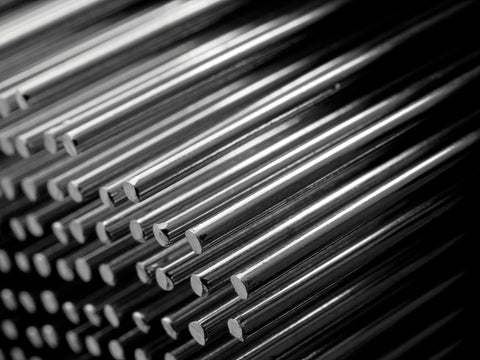
3CR13 Steel
3CR13 Steel is most commonly used for knives and is a form of Chinese stainless steel. It is similar in many respects to 420J2 (AUS 4) stainless steel..
L6 Bainite Steel
L6 steel is a brilliant steel which is suitable for many applications, it’s equally practical for knives as well as swords. When used in a sword, L6 steel will likely be heat treated until a Bainite microstructure is formed, this process is complicated and expensive to perform. The steel is very popular in for use when forging Japanese Katana and its influence is spreading to other forgers creating non-Japanese swords. As the process spreads we’ll likely see efficiencies in formation of Bainite, leading to a reduction in the cost and the swords will likely see mass market distribution.
It relatively uncommon to see L6 used in production knives or swords, the steel is very difficult to work with and as such it’s really only found in custom pieces or high priced items.
Damascus Steel
Damascus steel swords are highly desirable due to their inherit beauty and practical application. Modern Damascus swords are formed from special types of billet steel. The billet steel is made up from several types of layers of steel and iron welded together, which is what creates the unique pattern present in Damascus steel.
Folded Steel
Folded steel swords are fascinating for their aesthetic attractiveness and their traditional heritage. One of the best known aspects of the Japanese traditional sword forging process involves folding the steel, the process involves repeatedly folding and hammering out the steel billet. Traditionally the process was performed in order to even out the carbon content of the steel throughout the sword, now the process is mostly performed due to aesthetics and to adhere to traditional techniques. The process is heavily referenced in much of Japanese popular culture is not synonymous with Japanese sword forging.
K120C Powder Steel
ASSAB K120C powder steel is made in Japan under a license agreement from SSAB of Sweden. The steel is typically considered to be similar to 1095 carbon steel.
Aluminium Swords
Most swords produced in Japan are not made of steel as you would expect, in fact they are invariably made from aluminium alloys. The overriding reason for this is the cost of a true Japanese sword is far in excess of what most people can afford. Japanese sword laws are incredibly strict and forges can make a maximum of two swords a month, which pushes the price up to a significant amount. This forces most martial artist practitioners to opt for a aluminium sword. Aluminium is significantly cheaper than a steel sword, but it also cannot be sharpened and doesn’t have the same heft as a real steel katana.
source https://www.bladespro.co.uk/blogs/news/guide-to-sword-steel-everything-you-didn-t-know-you-needed-to-know

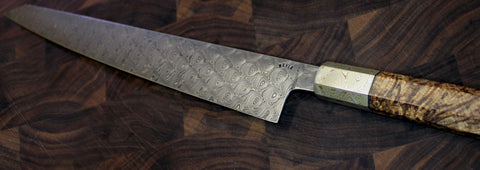
No comments:
Post a Comment